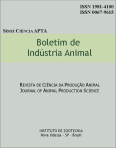Comparison of methodologies for assessment of pork loin eye area
DOI:
https://doi.org/10.17523/bia.v71n3p211Palabras clave:
AutoCAD®, Echo Image Viewer, paper weight, plastic grid, point countingResumen
The determination of loin eye area (LEA) is one of the most common methods to assess carcass quality and it is possible to adjust calculations to predict meat amount in the carcass which is one of the important features in the classification process. The aim of this study was to compare different methodologies used to determine LEA in swine. Fifteen crossbred pigs, Landrace x Large White, males and females, were slaughtered at 140 days of age. After 24 hours of cooling at 4°C, the Longissimus dorsi muscle was removed from the left half part of carcasses for evaluation of LEA between the 12th and 13th rib. The methods were: point counting on plastic grid of 1 cm2 and 0.25 cm2 (PCGP 1 cm2 and PCGC 0.25 cm2), circumference method by Echo Image Viewer (ECHO), circumference method using AutoCad ® program (CAD) and method of weighing paper (WP). The design was completely randomized with 15 replications per treatment and the data were subjected to Pearson correlation and variance analysis. Averages were compared by Tukey test at a significance level of 5%. LEA values were: 35.84, 35.69, 33.86, 34.22 and 36.71 cm2, for the PCGP 1 cm2, PCGP 0.25 cm2, ECHO, CAD and WP methods, respectively. The LEA values determined by methods PCGP 1 cm2, PCGP 0.25 cm2 and WP were similar; however they were higher than those obtained by the ECHO and CAD methodologies (P<0.0001). PCGP 1 cm2, PCGP 0.25 cm2 and WP methods may overestimate LEA values. The choice of method to be used should be based on its practicality and availability of resources, since the difference obtained between them is low.Descargas
Descargas
Publicado
Número
Sección
Licencia
Os autores não serão remunerados pela publicação de trabalhos, pois devem abrir mão de seus direitos autorais em favor deste periódico. Por outro lado, os autores ficam autorizados a publicar seus artigos, simultaneamente, em repositórios da instituição de sua origem, desde que citada a fonte da publicação original seja Boletim de Indústria Animal. A revista se reserva o direito de efetuar, nos originais, alterações de ordem normativa, ortográfica e gramatical, com vistas a manter o padrão culto da língua e a credibilidade do veículo. Respeitará, no entanto, o estilo de escrever dos autores. Alterações, correções ou sugestões de ordem conceitual serão encaminhadas aos autores, quando necessário. Nesses casos, os artigos, depois de adequados, deverão ser submetidos a nova apreciação. As opiniões emitidas pelos autores dos artigos são de sua exclusiva responsabilidade. Todo o conteúdo deste periódico, exceto onde está identificado, está licenciado sob a Licença Creative Commons Attribution (CC-BY-NC). A condição BY implica que os licenciados podem copiar, distribuir, exibir e executar a obra e fazer trabalhos derivados com base em que só se dão o autor ou licenciante os créditos na forma especificada por estes. A cláusula NC significa que os licenciados podem copiar, distribuir, exibir e executar a obra e fazer trabalhos derivados com base apenas para fins não comerciais.













